Terrariums are a fun way to get creative and express yourself with your houseplant hobby. These adorable micro-habitats are the perfect place to keep humidity-sensitive plants, but they can be so much more.
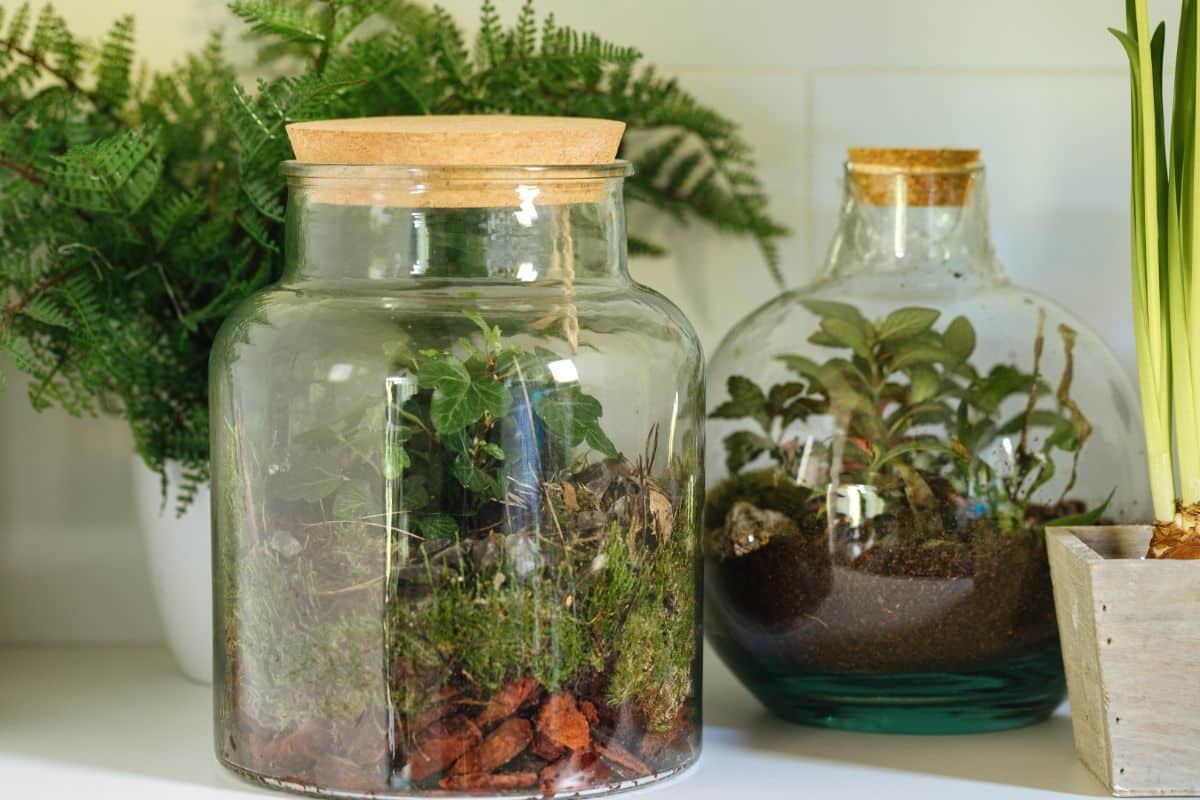
Open terrariums are just the place to pot up small succulents, cacti, and other mini tropical plants that may get lost in your larger houseplant collection. On the other hand, closed terrariums have lids or covers to trap in humidity and will help you to keep finicky plants, like ferns and nerve plants, looking their best.
In the list below, we’ve curated some of our favorite tiny plants for any kind of terrarium. All you need is a bit of soil, your favorite terrarium enclosure, and a little imagination to create a personalized terrarium you can enjoy for years.
Jump to:
- 21 best miniature plants to keep in terrariums
- 1. Ferns
- 2. Pitcher plant (Nepenthes spp.)
- 3. Polka dot plant (Hypoestes phyllostachya)
- 4. Venus flytrap (Dionaea muscipula)
- 5. Creeping fig (Ficus pumila)
- 6. Air plants (Tillandsia spp.)
- 7. Aluminum plant (Pilea cadierei)
- 8. Pothos (Epipremnum aureum)
- 9. Moss
- 10. Succulents
- 11. Nerve plant (Fittonia albivenis)
- 12. Baby tears (Soleirolia soleirolii)
- 13. Miniature African violet (Saintpaulia Ionantha)
- 14. Miniature English Ivy (Hederahelix)
- 15. Cacti
- 16. Arrowhead vine (Syngonium podophyllum)
- 17. Spike moss (Selaginellaceae spp.)
- 18. Strawberry begonia (Saxifraga stolonifera)
- 19. Miniature orchid (Orchidaceae spp.)
- 20. Friendship plant (Pilea involucrata)
- 21. Sundew (Drosera spp.)
- Frequently asked questions
- Summary
21 best miniature plants to keep in terrariums
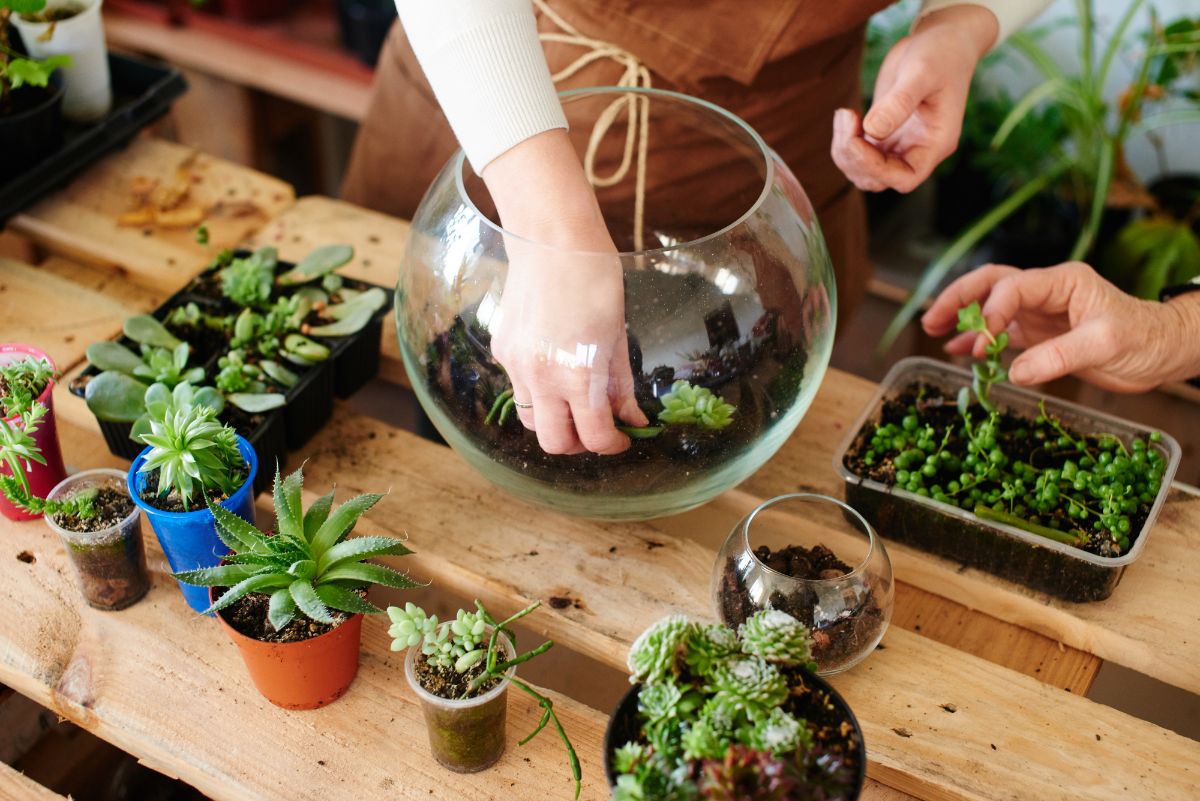
From humidity-loving mosses and carnivorous plants to hardy cacti and succulents, there are lots of mini plants you can keep in terrariums. We’ve included a wide variety of plants in different colors and shapes in our list below to suit any taste and houseplant aesthetic.
1. Ferns
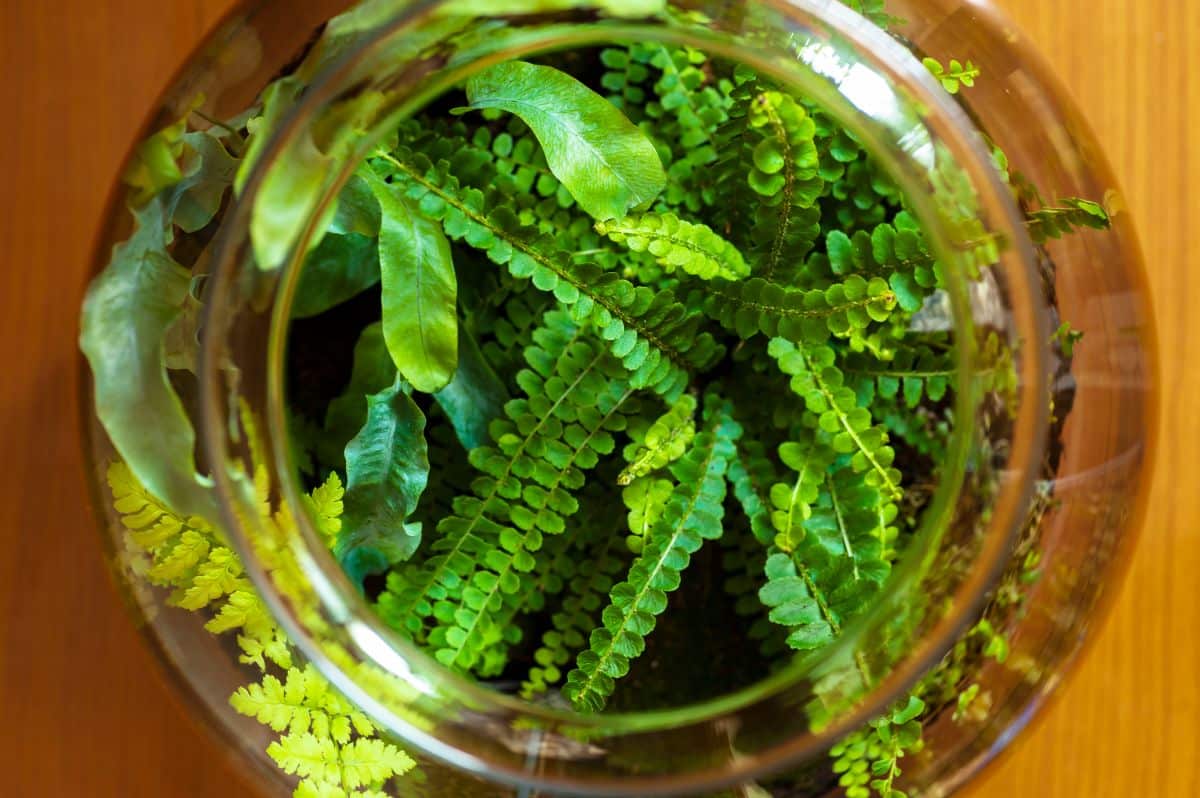
| Plant name: | Ferns |
| Lighting requirements: | Bright, indirect light |
| Watering requirements: | High to moderate |
| Closed or open terrarium: | Closed |
| Special features: | Excellent foliage plants – wide range of leaf shapes. |
Ferns are humidity-loving plants, and it can be difficult to keep them indoors, as many homes have dry air. While adding a humidifier or pebble tray to your grow setup can help, potting up your ferns in terrariums can be an even easier solution. Because terrariums can be closed systems, you won’t need to worry about your ferns drying out, and they will need much less maintenance when grown in this manner.
Some fern species (such as Boston ferns) grow rather large, making it difficult to keep them in terrariums. Instead, look for fern varieties that stay smaller or keep your ferns well-pruned to ensure they don’t outgrow your terrarium. Some great fern types for terrarium growing include the heart fern, lemon button fern, and bird’s nest fern.
2. Pitcher plant (Nepenthes spp.)
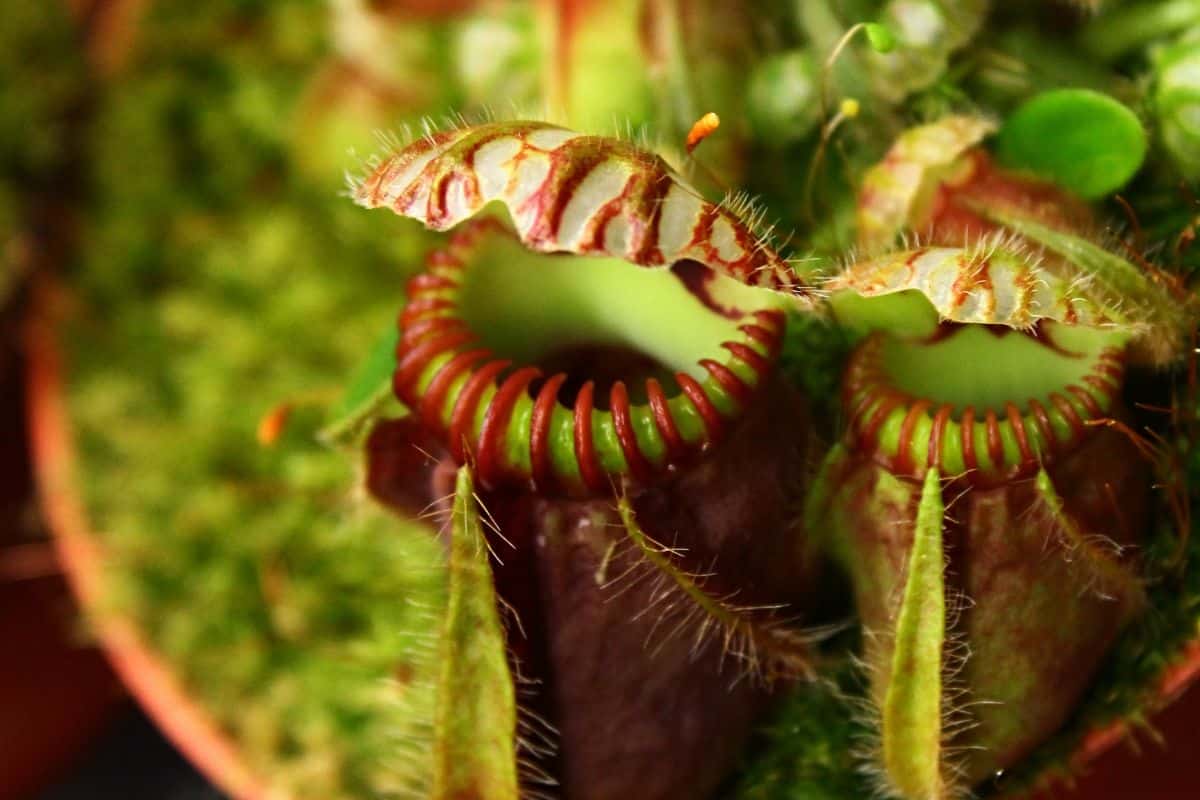
| Plant name: | Pitcher plant |
| Lighting requirements: | Bright, indirect light |
| Watering requirements: | High to moderate |
| Closed or open terrarium: | Closed |
| Special features: | Carnivorous plant |
Pitcher plants are carnivorous plants that are native to Australia, Southeast Asia, and Madagascar. There are also American pitcher plants that are native to North America; however, these plants are distantly related and have a slightly different shape.
Pitcher plants use their pitcher-shaped traps to lure and capture insects, which they digest and consume for added nutrients. This is because these plants are naturally found in nutrient-poor environments and need additional nutrients that can’t be found in their native soil.
In terrarium setups, pitcher plants are ideal as these species thrive in high humidity. In fact, many pitcher plants will even stop producing pitchers if they are kept in locations with lower than 50% humidity. Many pitcher plants will also stay quite small, so you won’t need to worry about them outgrowing your terrarium.
3. Polka dot plant (Hypoestes phyllostachya)
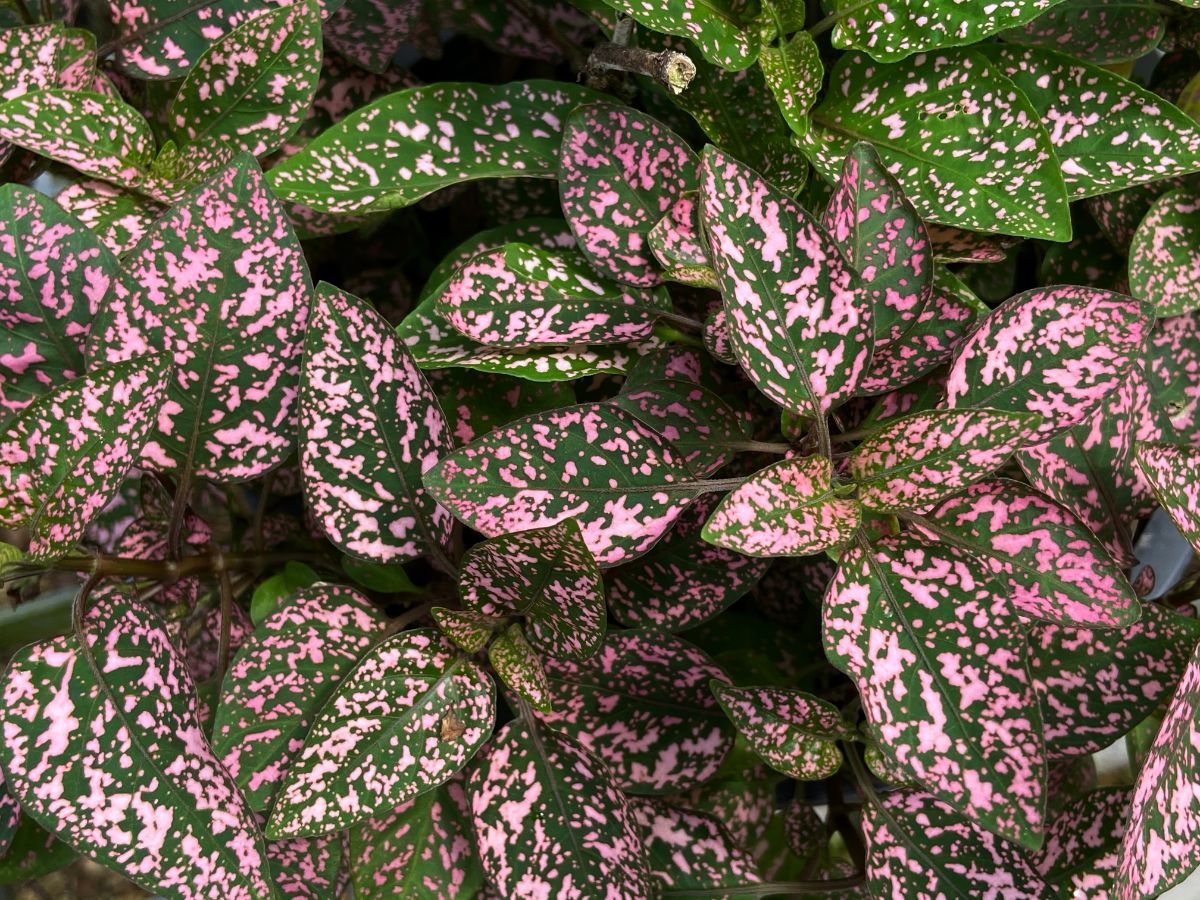
| Plant name: | Polka dot plant |
| Lighting requirements: | Bright, indirect light |
| Watering requirements: | High to moderate |
| Closed or open terrarium: | Closed |
| Special features: | Colorful leaves |
Polka dot plants are another houseplant that loves humidity, and they will wilt dramatically if they’re allowed to dry out. These plants can also suffer from crispy leaves in dry homes. Planting them in terrariums, on the other hand, will make these plants much easier to keep.
As their name implies, polka dot plants feature highly colored and patterned leaves that are accentuated with vibrant dots in pink and white. When fully mature, these plants grow about 30” high, but you can keep them smaller with frequent pruning. For a colorful terrarium display, try planting several different polka dot plants together, or combine them with other colorful foliage plants, like arrowhead vines.
4. Venus flytrap (Dionaea muscipula)
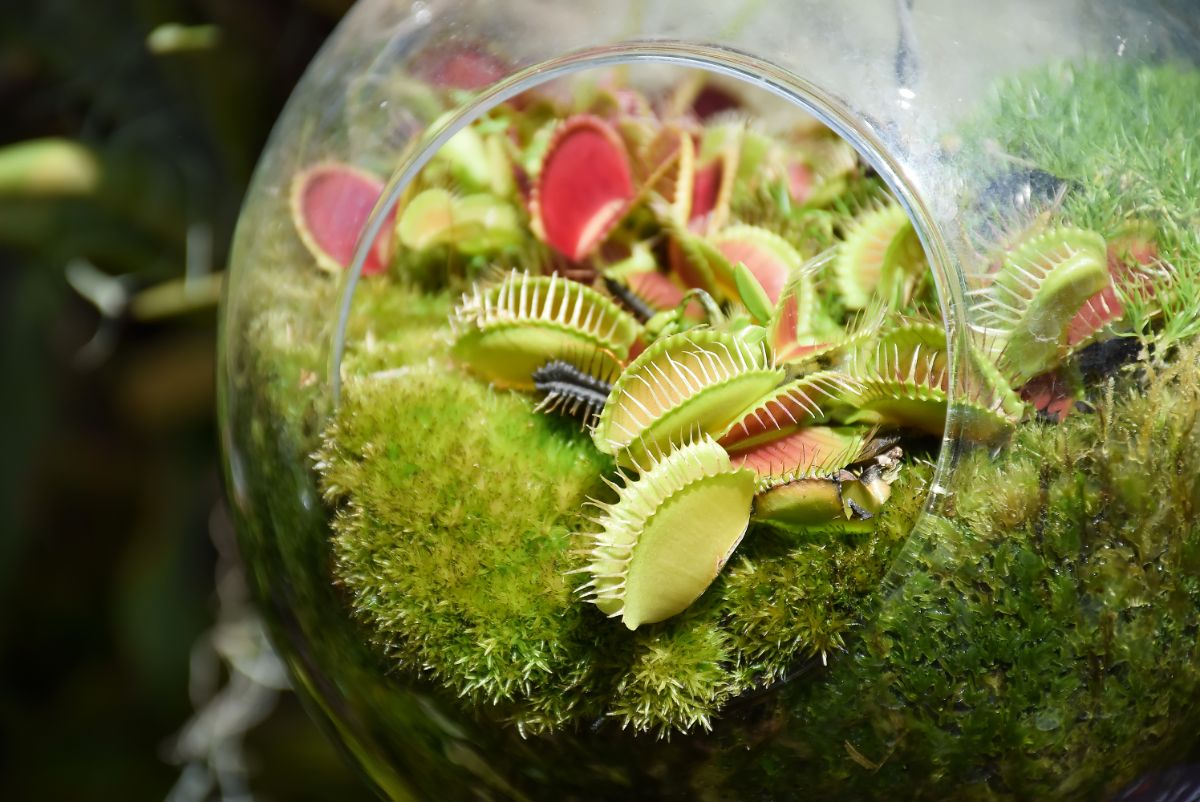
| Plant name: | Venus flytrap |
| Lighting requirements: | Bright light |
| Watering requirements: | High to moderate |
| Closed or open terrarium: | Closed |
| Special features: | Carnivorous plant |
Like pitcher plants, the Venus flytrap is another humidity-loving, carnivorous plant that is easy to keep in terrariums. These plants are native to boggy areas in the coastal Carolinas of the United States. Growing in low-fertility soil, these plants eat flies and other pests as a way to supplement the nutrients they need to grow.
Venus flytraps rarely grow over 12” tall, making them the perfect size for terrariums. Just be sure to provide these plants with plenty of bright light and avoid activating the traps unnecessarily, as this can use up the plants’ energy reserve. Additionally, because these plants are sensitive to chemicals, never fertilize them and only water them with rain or distilled water.
Hint: If you love the look of carnivorous plants, you can enhance your plant design even further by looking for terrarium kits that look like miniature greenhouses. Some terrariums are even modeled after Victorian greenhouses to complement the “spooky” look of Venus flytraps.
5. Creeping fig (Ficus pumila)
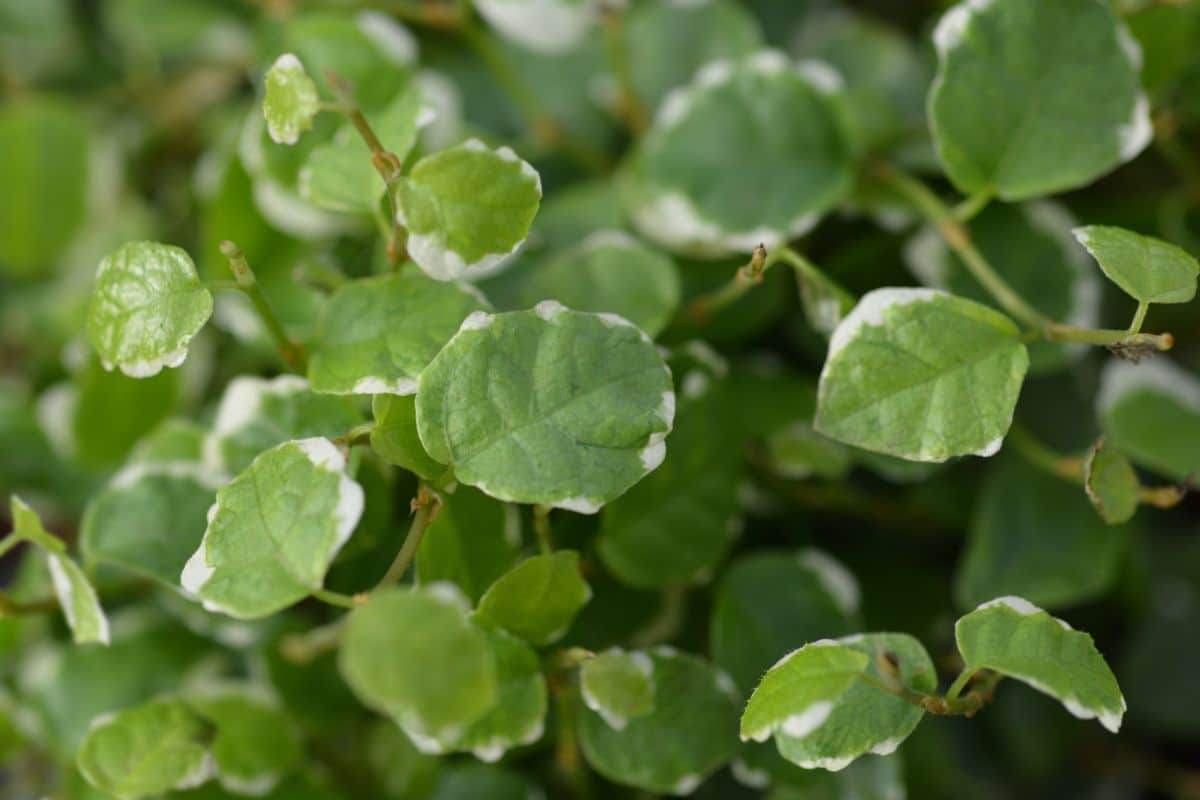
| Plant name: | Creeping fig |
| Lighting requirements: | Bright, indirect light |
| Watering requirements: | High to moderate |
| Closed or open terrarium: | Closed |
| Special features: | Vining |
Creeping fig vines are often grown outdoors as a ground or wall covering in temperate climates, but they can make delightful houseplants as long as they receive enough humidity. This can, at times, be difficult to accomplish, especially in winter when indoor heat dries out the air.
Keeping your creeping fig in a terrarium will ensure that your plant receives enough humidity throughout the day. These plants have solid green or variegated leaves that are very petite. Those mini leaves look particularly appealing in terrarium setups and can be the perfect addition to terrarium fairy gardens too!
6. Air plants (Tillandsia spp.)
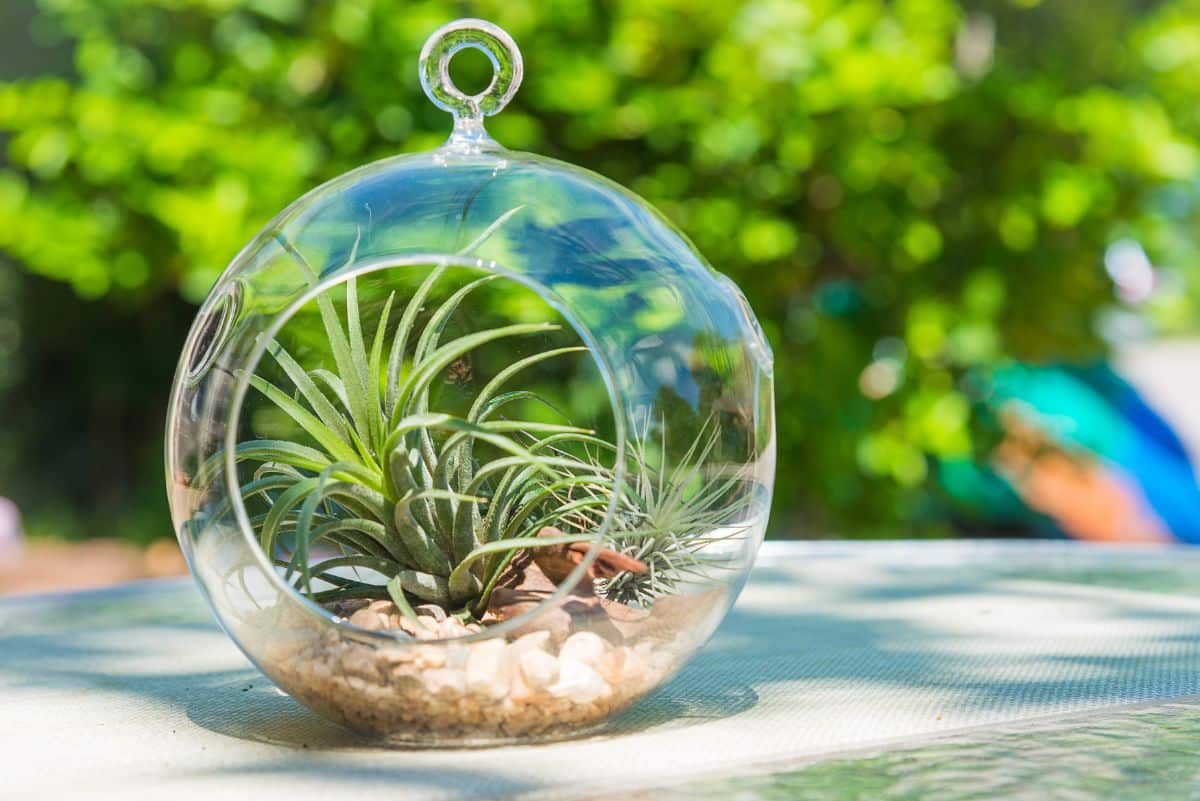
| Plant name: | Air plants |
| Lighting requirements: | Bright, indirect light |
| Watering requirements: | Moderate |
| Closed or open terrarium: | Closed or open |
| Special features: | Colorful flowers |
Since there are over 650 different species of air plants, you’ll have plenty of plants to choose from if you’d like to keep Tillandsia in your homemade terrarium. These easy-going plants don’t have super high humidity needs like some of the other plants on this list, but their small size makes them ideal for terrarium kits.
Air plants are epiphytes in nature and get most of the water and nutrients they need from the ambient air. In a terrarium, you may not need to water your air plants at all – just give them the occasional misting with a hand sprayer to keep their leaves moist. Air plants also rarely need fertilizer and bloom very colorful flowers when they mature.
7. Aluminum plant (Pilea cadierei)
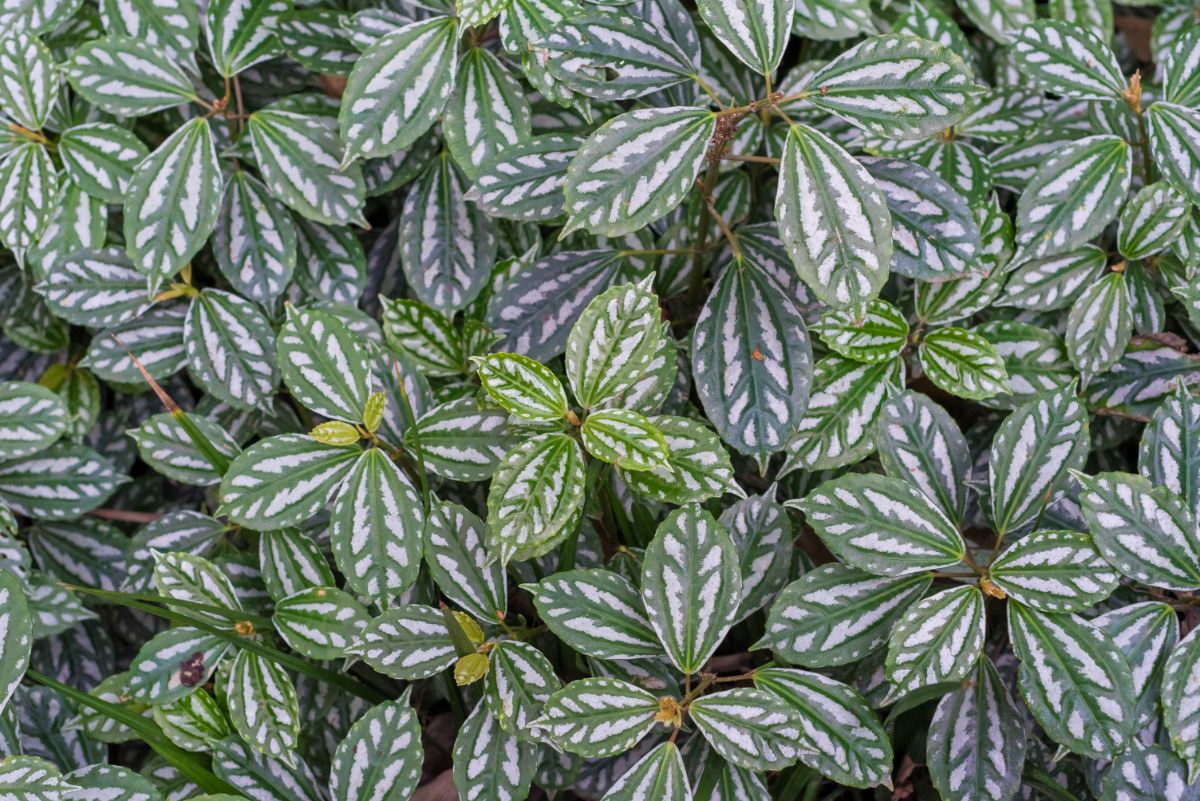
| Plant name: | Aluminum plant |
| Lighting requirements: | Bright, indirect light |
| Watering requirements: | High to moderate |
| Closed or open terrarium: | Closed |
| Special features: | Colorful leaves |
Aluminum plants are named after their variegated leaves that have streaks of silvery coloration that complement the green undertones of the plant beautifully. Often grown outdoors in warmer regions, aluminum plants are adaptable and can be kept as houseplants too. However, their high humidity needs can make them tricky to keep unless you grow them in terrariums or near a humidifier.
Once mature, aluminum plants will grow to between 1 and 2’ high, but you can keep them smaller with pruning. These plants also propagate easily in both soil and water, so don’t toss out your plant cuttings after you prune your plant! Instead, try to propagate your plants from the stems and leaves you removed from the parent plant.
8. Pothos (Epipremnum aureum)
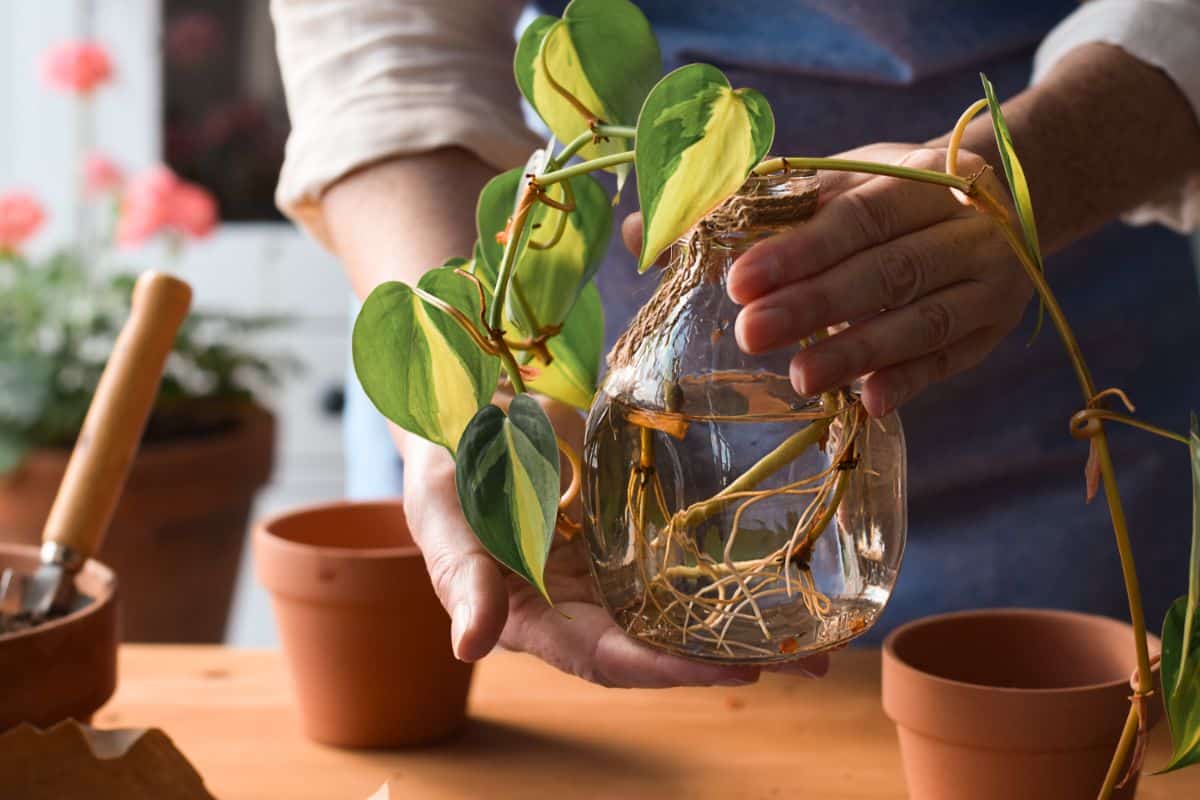
| Plant name: | Pothos |
| Lighting requirements: | Bright, indirect light to low light |
| Watering requirements: | Moderate |
| Closed or open terrarium: | Closed or open |
| Special features: | Vining |
Pothos are some of the lowest-maintenance houseplants you can keep. They grow happily in pots, hanging baskets, vases of water, and yes, of course, terrariums too!
Because pothos are vining species, you will need to prune your plants occasionally to avoid overcrowded terrariums. As with aluminum plants, don’t throw your pothos cuttings away, as these plants readily propagate in both soil and water.
For more variety in your terrarium, try choosing some of the more colorful pothos varieties, or pot up several different types together for even more flair. Some of the most popular pothos varieties include ‘Marble Queen,’ ‘Neon’ and ‘Glacier.’
9. Moss
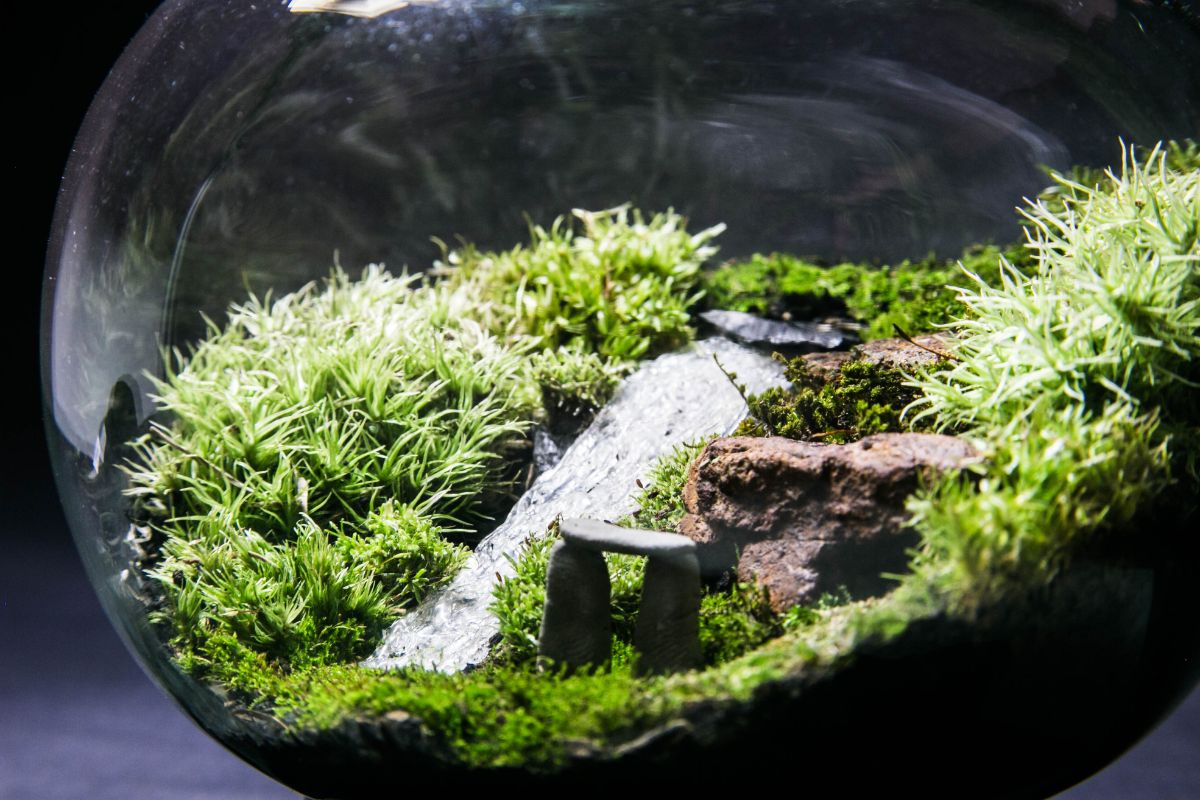
| Plant name: | Moss |
| Lighting requirements: | Bright, indirect light to low light |
| Watering requirements: | High to moderate |
| Closed or open terrarium: | Closed |
| Special features: | Excellent filler plant |
Mosses are generally low-maintenance plants that prefer moist soil and high humidity levels. Their compact size makes them perfect for terrarium setups, and they also often grow well in lower-light situations. Even better, mosses low profiles make them exceptional choices for filling in bare spots in your terrarium design to make a more colorful and cohesive look.
Which mosses you choose to grow in your terrarium is up to you, but some popular choices include pillow moss, fern moss, and feather moss. You may also be able to forage for live mosses in the wild on hikes and other outdoor excursions. Just make sure you follow local guidelines when harvesting from nature.
10. Succulents
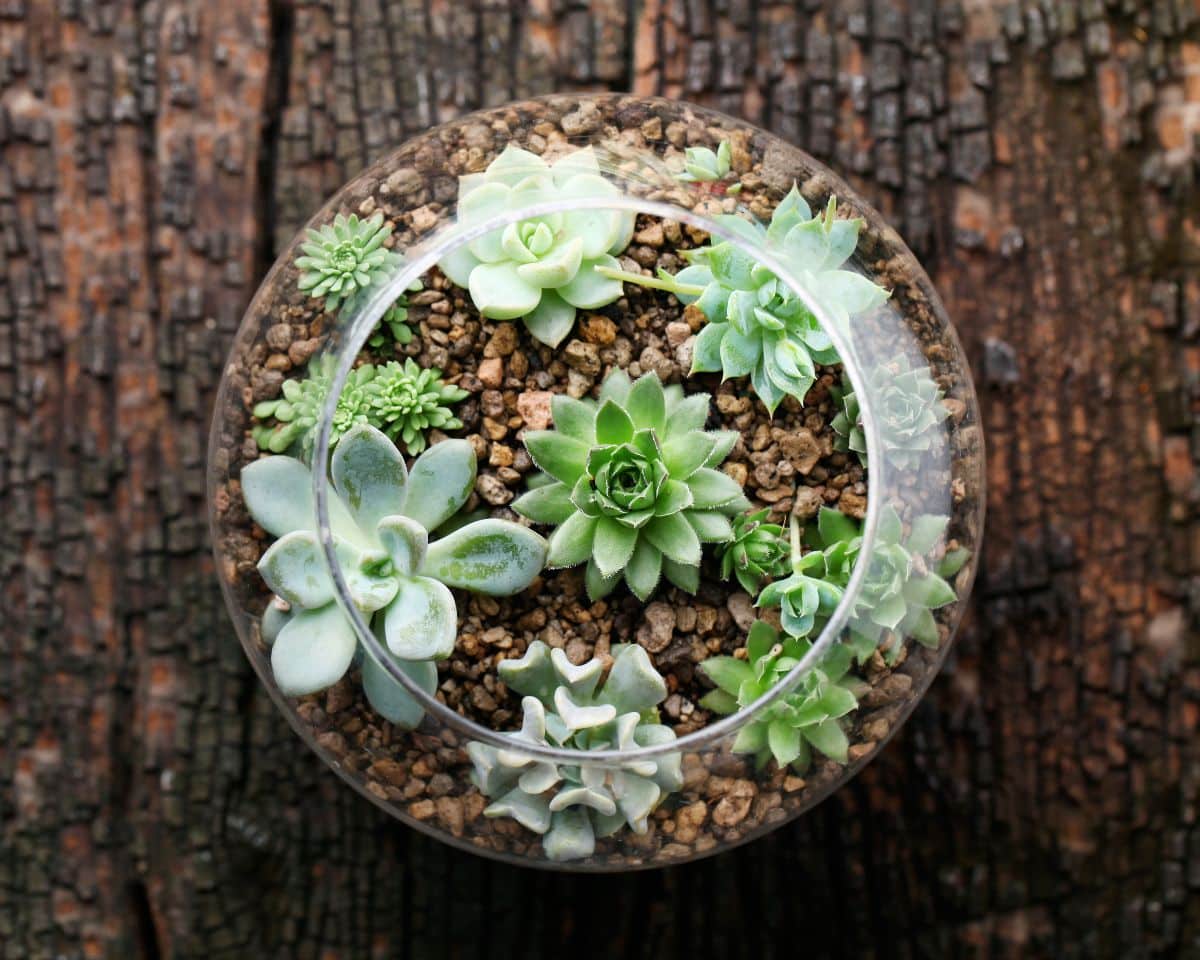
| Plant name: | Succulents |
| Lighting requirements: | Bright light |
| Watering requirements: | Low |
| Closed or open terrarium: | Open |
| Special features: | Colorful leaves; fun shapes |
Many of the plants we’ve covered so far are just right for closed terrarium setups that maintain high humidity levels. However, succulents can be grown in open terrariums as they don’t need high humidity and prefer to grow in dry conditions. This means you’ll have lots more terrarium choices to choose from if you want to grow these low-maintenance plants.
Succulents come in all shapes and colors – including the ever-popular jade plants, echeveria, aeonium, and haworthia. You can also look for less common succulent types, such as moonstones, baby toes, and lithops. Regardless of which succulents you choose to grow, make sure you provide your terrarium with lots of bright light, as these plants need plenty of sun to grow properly.
11. Nerve plant (Fittonia albivenis)
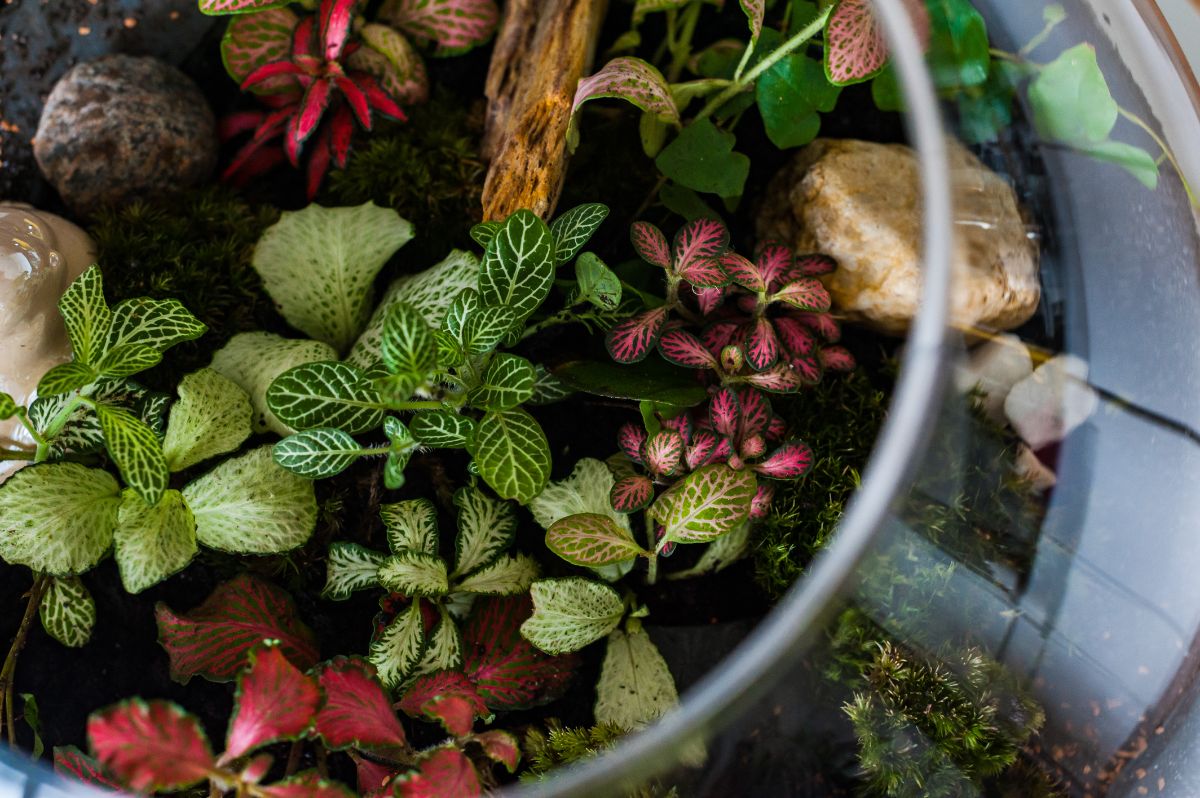
| Plant name: | Nerve plant |
| Lighting requirements: | Bright, indirect light to low light |
| Watering requirements: | High to moderate |
| Closed or open terrarium: | Closed |
| Special features: | Colorful leaves |
Nerve plants look a lot like polka dot plants, but while polka dot plants feature spotted leaves, nerve plants have striped leaves with highly contrasting veins. These trailing plants stay small, growing about 3 to 6” high, but they can spread 18” wide. Occasionally, nerve plants will flower, but they are mostly known for their colorful leaves that come in greens, white, red, and pink.
Like polka dot plants, nerve plants prefer higher-than-average moisture levels and can rapidly wilt in dry conditions. Keeping these sensitive plants in terrariums will cut down on their care requirements significantly and help prevent crispy leaves. Nerve plants are native to South America and grow best in bright, indirect light as too much direct sun can cause leaf scorching.
12. Baby tears (Soleirolia soleirolii)
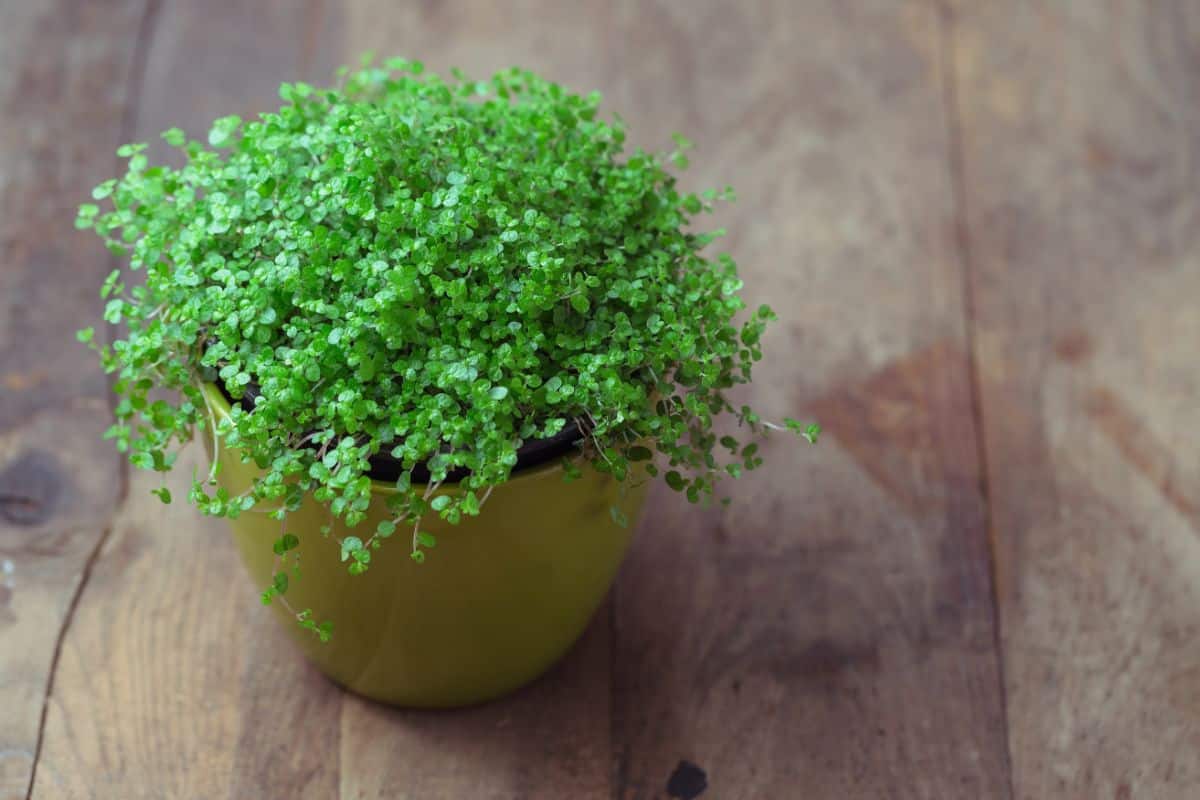
| Plant name: | Baby tears |
| Lighting requirements: | Bright, indirect light |
| Watering requirements: | High to moderate |
| Closed or open terrarium: | Closed |
| Special features: | Trailing |
Baby tears may look like fern, but they are actually members of the nettle family – although they don’t cause painful stings! These plants are beginner-friendly, but to grow them properly, you do need to follow a few simple steps. Mainly, baby tears require at least 75% humidity, which makes them a perfect choice for terrariums.
Because baby tears grow best in partial shade, they are adaptable enough to tolerate lower-light homes. Their low-growing habit and tiny leaves also makes them a fine choice as an accent plant to add extra color and fill in bare spots in your terrarium. When mature, baby tears grow about 4” high and can form a low mat, spreading up to 36” across.
13. Miniature African violet (Saintpaulia Ionantha)
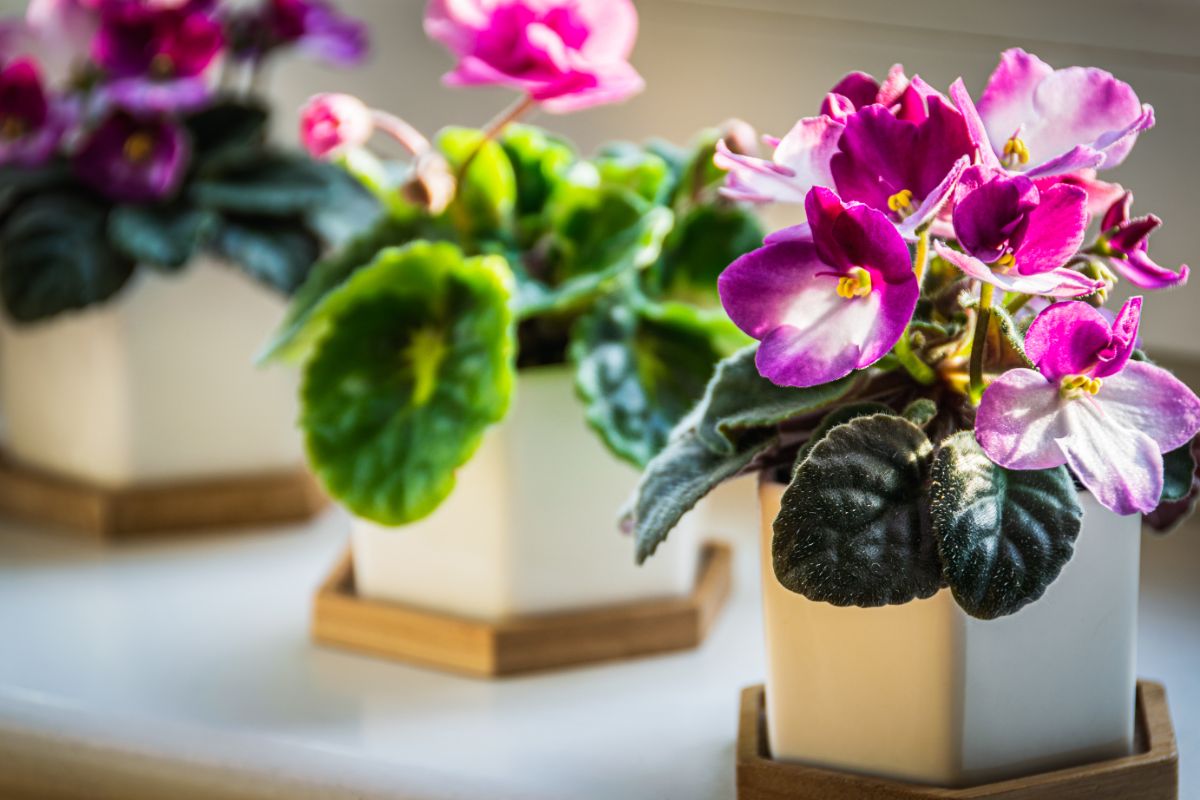
| Plant name: | Miniature African violet |
| Lighting requirements: | Bright, indirect light |
| Watering requirements: | Moderate |
| Closed or open terrarium: | Closed or open |
| Special features: | Colorful flowers; textured leaves |
African violets are a top choice among beginning houseplant keepers for a good reason: they are incredibly low maintenance! These happy little plants have moderate watering needs and don’t crave humidity like some of the other plants on this list. That said, African violets are tropical plants, and their small size makes them well-adapted to terrarium living.
African violets are mostly known for their adorable flowers that come in white, pink, and purple and may or may not have ruffled petals or double blooms. These classic plants also feature thick, furry leaves that add a nice pop of color to terrariums. Just remember to water carefully as these plants don’t like to get their leaves wet.
14. Miniature English Ivy (Hederahelix)
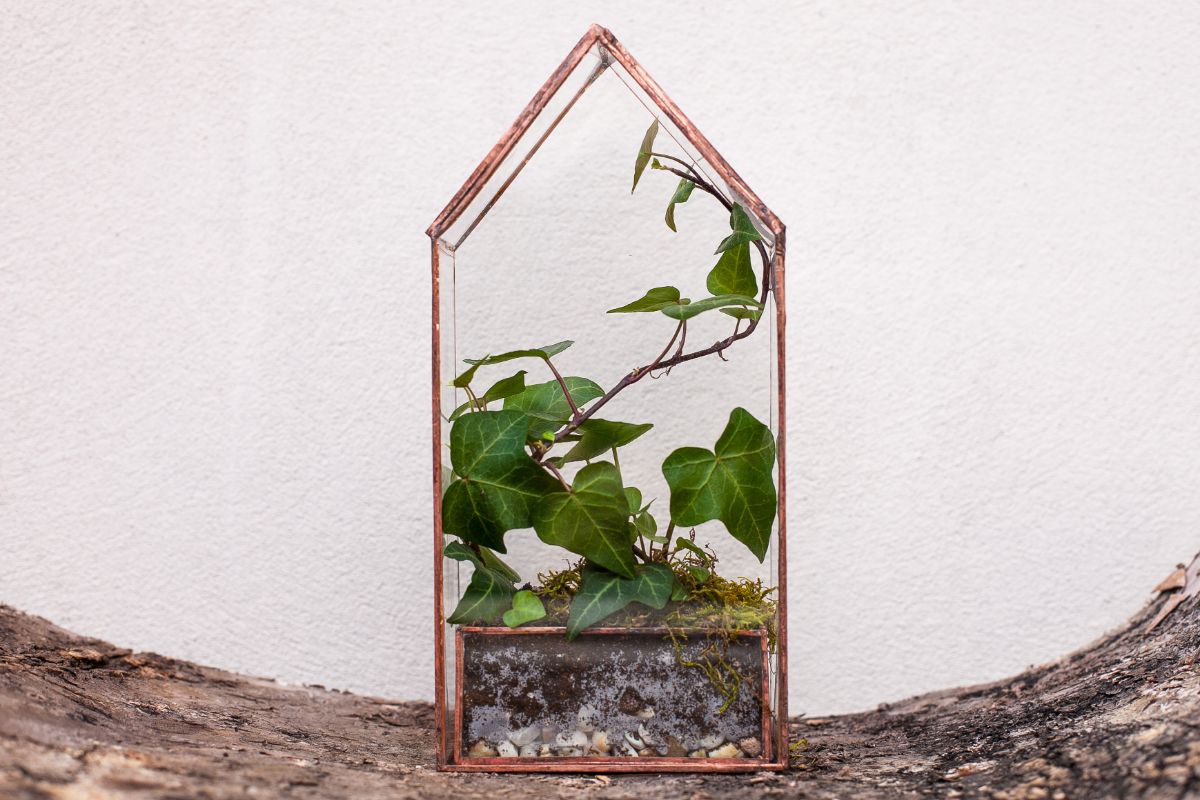
| Plant name: | Miniature English ivy |
| Lighting requirements: | Bright to bright, indirect light |
| Watering requirements: | Moderate |
| Closed or open terrarium: | Closed or open |
| Special features: | Vining |
English ivy is a vigorously growing plant that can be quite destructive if it’s allowed to go wild. Prone to invasiveness when grow outdoors, English ivy can still spell trouble for houseplant keepers as its roots can damage plaster and drywall. To avoid these issues, some plant parents opt to grow their ivy plants in terrariums, which will help keep these plants more manageable.
Miniature English ivy is smaller than the standard variety, with small leaves that look very pretty in terrariums and enclosed miniature fairy gardens. Like standard ivy, leaves are lobed and glossy and come in both solid green and variegated options. Because English ivy prefers higher humidity, these plants grow best in closed terrariums where moisture levels are easier to maintain.
15. Cacti
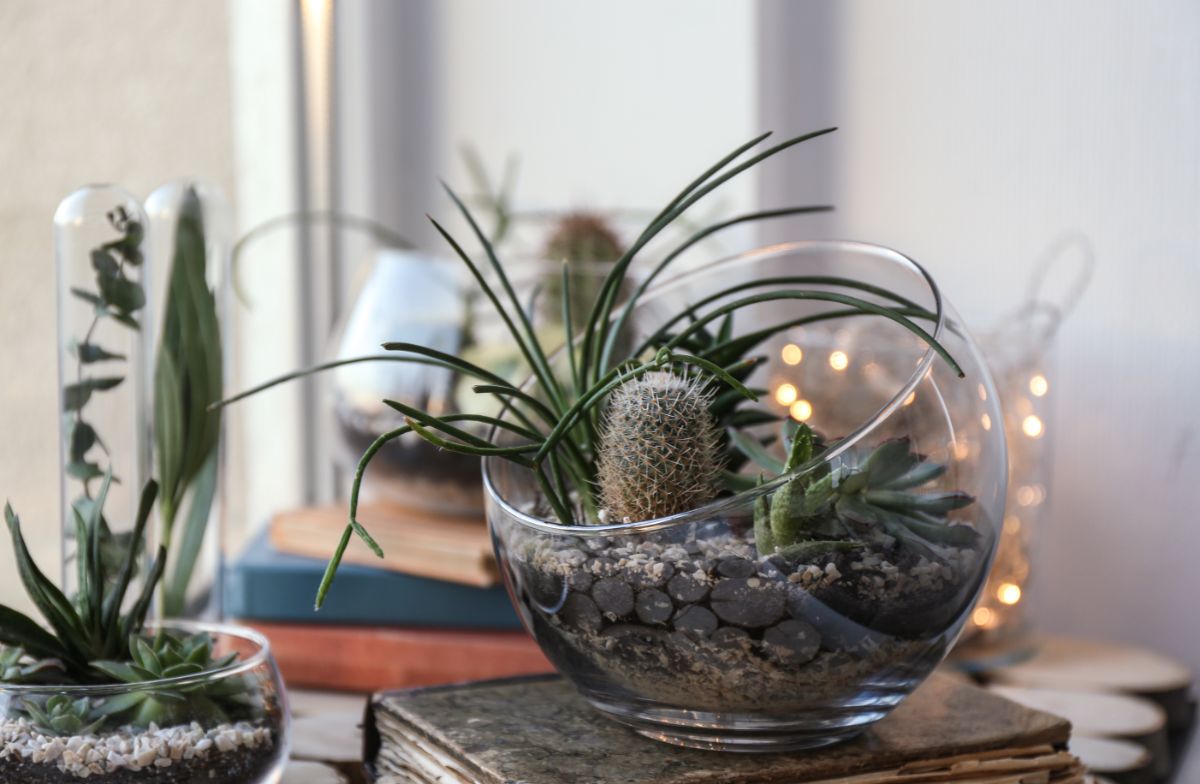
| Plant name: | Cacti |
| Lighting requirements: | Bright light |
| Watering requirements: | Low |
| Closed or open terrarium: | Open |
| Special features: | Colorful; fun shapes |
Like succulents, cacti are beginner-friendly plants that have minimal watering needs. Growing best in open terrariums, most cacti require bright light, but are otherwise low-maintenance plants. Many cacti are also small and slow growing and won’t overwhelm terrarium setups, even if you choose to grow a bunch of cacti all together.
Cacti come in all shapes and sizes, and some colorful options are available too. Moon cacti are always popular and are known for their highly contrasting green stems and orb-shaped tops that come in yellows, oranges, pinks, and reds. Some other popular cactus picks for terrariums include the barrel cactus, old man cactus, and ladyfinger cactus.
16. Arrowhead vine (Syngonium podophyllum)
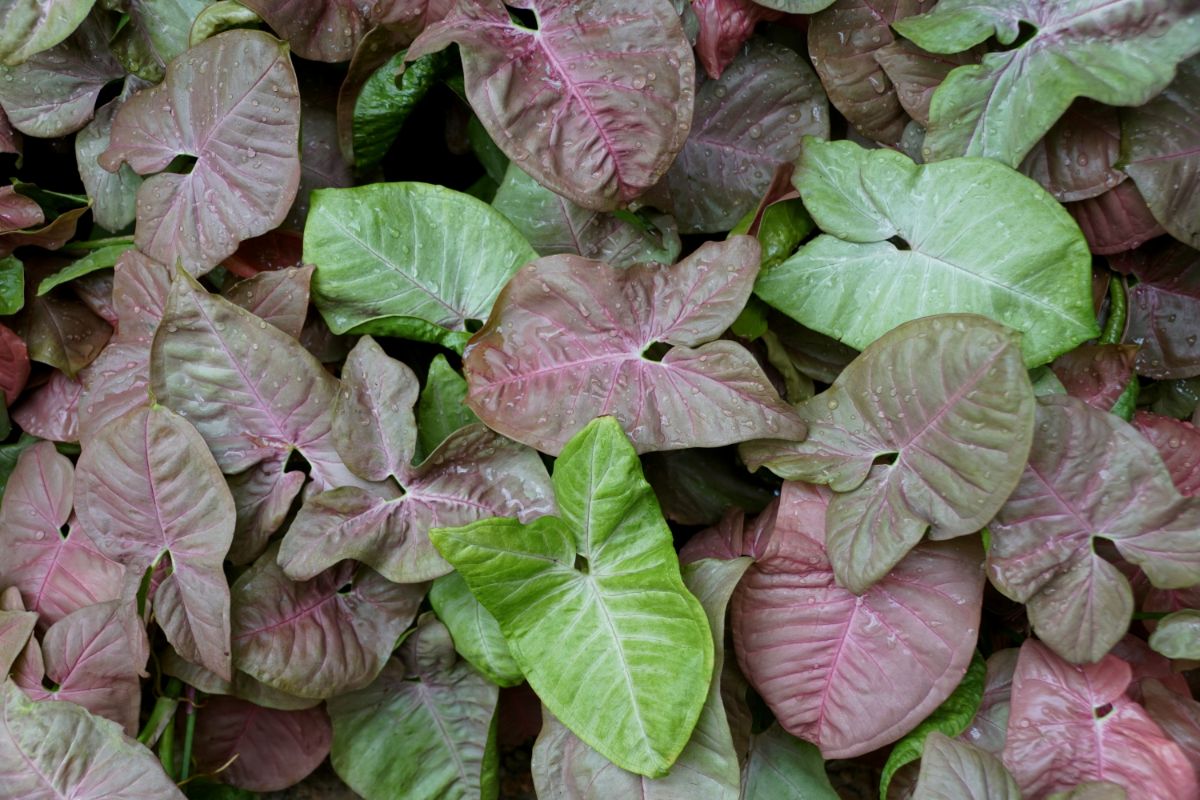
| Plant name: | Arrowhead vine |
| Lighting requirements: | Bright, indirect light to low light |
| Watering requirements: | Moderate |
| Closed or open terrarium: | Closed or open |
| Special features: | Colorful leaves |
Arrowhead vines rank up there with pothos as being some of the easiest plants to keep. These vigorously growing plants are adaptable to even lower light situations, and they can tolerate a range of humidity levels. With proper pruning, arrowhead vines also excel as terrarium plants.
As their name suggests, arrowhead vines are known for their arrow-shaped leaves, which are most commonly available in green. For more color, look for pink or brown arrowhead vines, or shop around until you find the even more popular variegated cultivars. In terrariums, arrowhead vines can be allowed to trail naturally, or you can prop them up with popsicle sticks or bamboo stakes to keep them growing more vertically.
17. Spike moss (Selaginellaceae spp.)

| Plant name: | Spike moss |
| Lighting requirements: | Bright, indirect light |
| Watering requirements: | High to moderate |
| Closed or open terrarium: | Closed |
| Special features: | Excellent filler plant |
Despite its name, spike moss isn’t a moss, but is actually something known as a “fern ally.” Fern allies are not true ferns either, but they are similar in form and have similar growing requirements.
Spike mosses love moisture and can be difficult to grow outside of terrariums. In enclosed setups, moisture levels are much easier to maintain, resulting in happier plants that won’t develop brown or crispy leaves. Spike mosses are exceptionally pretty plants with feathery leaves with frosted margins and are certain to add texture and color to any terrarium design.
18. Strawberry begonia (Saxifraga stolonifera)
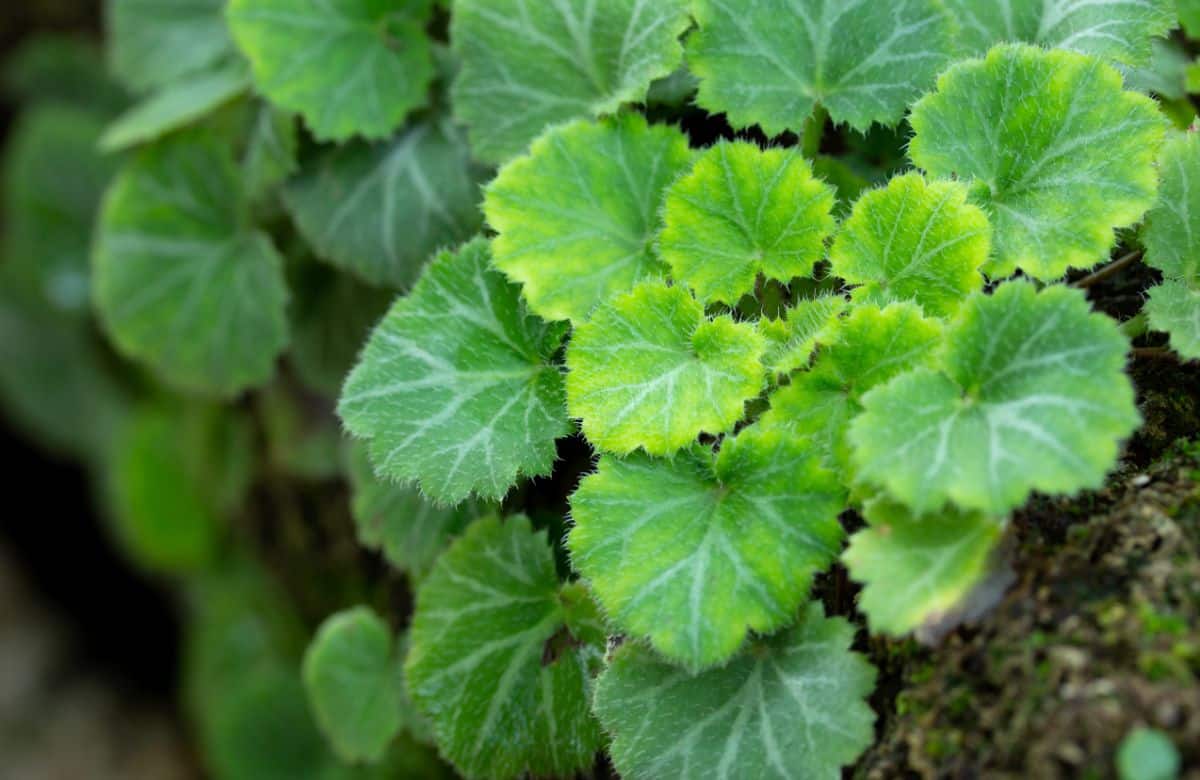
| Plant name: | Strawberry begonia |
| Lighting requirements: | Bright, indirect light |
| Watering requirements: | Moderate |
| Closed or open terrarium: | Closed or open |
| Special features: | Flowers |
Strawberry begonias are often kept in baskets, as they produce long and trailing runners that add lots of texture and vertical appeal when potted up in this manner. However, these adaptable plants can also be kept as tabletop or terrarium specimens and are sure to delight you with their distinctly furry leaves.
Many houseplant keepers choose to prune away some of the runners from these plants to keep their strawberry begonias looking more tidy. These runners can easily be rooted and placed into your terrarium to help expand your houseplant collection. Strawberry begonias thrive in average to high humidity levels and can adapt to partial shade or full sun.
19. Miniature orchid (Orchidaceae spp.)
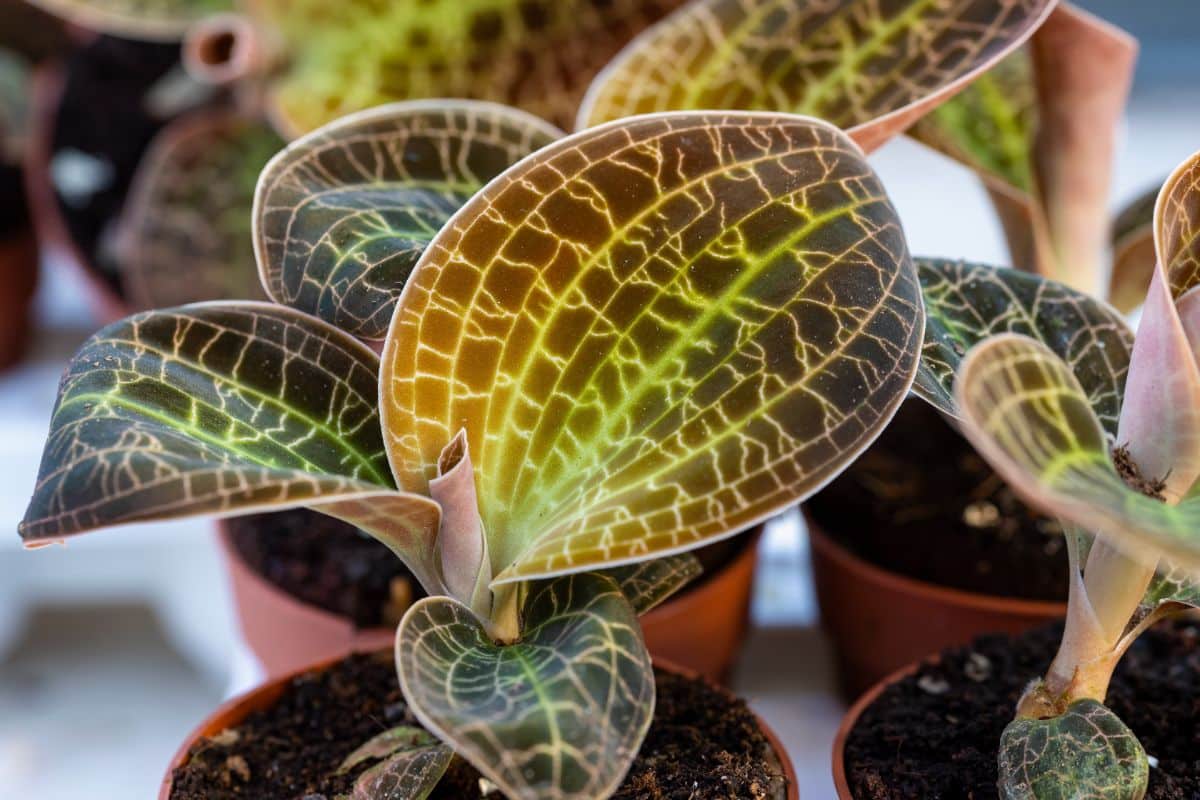
| Plant name: | Miniature orchid |
| Lighting requirements: | Bright, indirect light |
| Watering requirements: | Moderate |
| Closed or open terrarium: | Closed |
| Special features: | Colorful flowers |
If you love orchids, you’re in luck. There are over 28,000 different species of orchids, and they come in a huge variety of shapes and sizes, so you’re always certain to find a cultivar to fit your aesthetic and home. Some orchids grow tall, while others are pint-sized and just perfect for terrariums.
About 70% of orchids are epiphytes and naturally grow in the crooks of tree branches and other sheltered areas above the ground. As a result, these plants don’t do well when potted in a standard potting mix and should be grown in a well-draining substrate that’s suitable for orchids. Keeping this in mind and ensuring that your orchids aren’t waterlogged is key to growing orchids successfully.
Not all orchids are well-suited for terrariums, but some of the best choices for this growing setup include Masdevallia orchids, Dracula orchids, and Tolumnia orchids.
20. Friendship plant (Pilea involucrata)
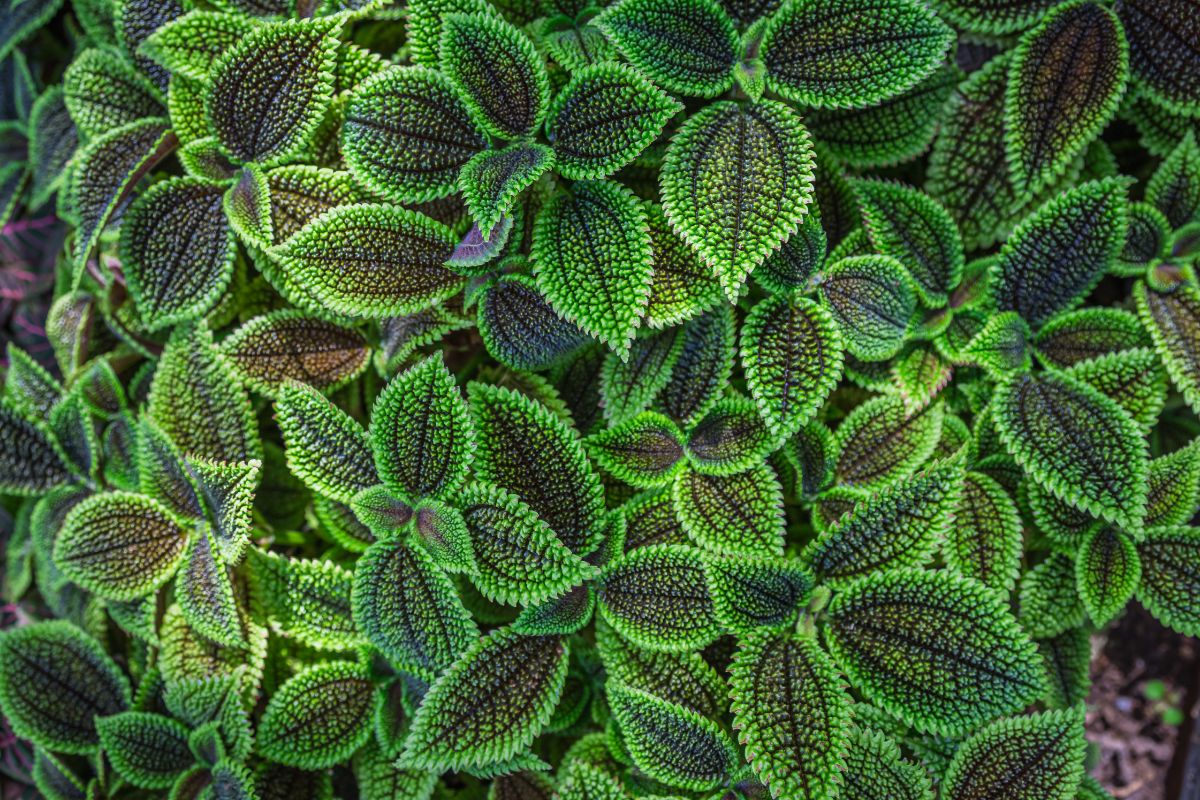
| Plant name: | Friendship plant |
| Lighting requirements: | Bright, indirect light |
| Watering requirements: | High to moderate |
| Closed or open terrarium: | Closed |
| Special features: | Colorful, textured leaves |
Friendship plants are named for how easy they are to propagate. Just place a stem in water or soil, and you’ll have new plants to share with friends in no time.
Well-known for their variegated leaves and low maintenance requirements, friendship plants are popular among houseplant keepers and terrarium enthusiasts alike. These plants are good choices for terrariums as they grow best in bright, indirect sun and prefer higher-than-average humidity levels. When mature, these plants still stay small and rarely grow taller than 6” in height.
21. Sundew (Drosera spp.)
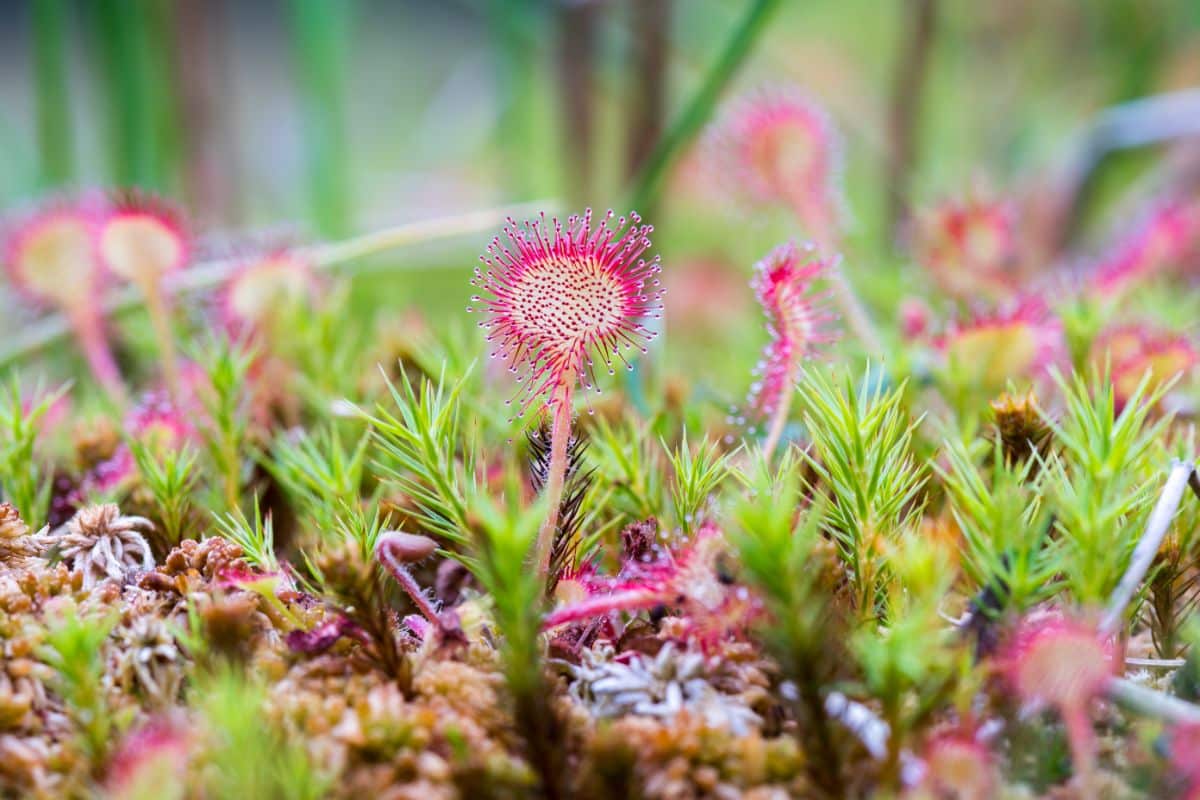
| Plant name: | Sundew |
| Lighting requirements: | Bright to bright, indirect light |
| Watering requirements: | High to moderate |
| Closed or open terrarium: | Closed |
| Special features: | Carnivorous plant |
Another carnivorous plant type that grows best in high humidity, sundews are often planted in terrariums as these closed setups make them easier to maintain. While Venus flytraps and pitcher plants use traps to catch their insect prey, sundews use the sticky drops on their fine, hairy leaves to capture and consume flies and other pests.
Sundews are found all over the world and on every continent except Antarctica. These plants naturally grow in boggy locations with slightly acidic soil, and they love the bright sun. Like other carnivorous plants, sundews are sensitive to chemicals and should be watered with distilled or rain water only.
Frequently asked questions
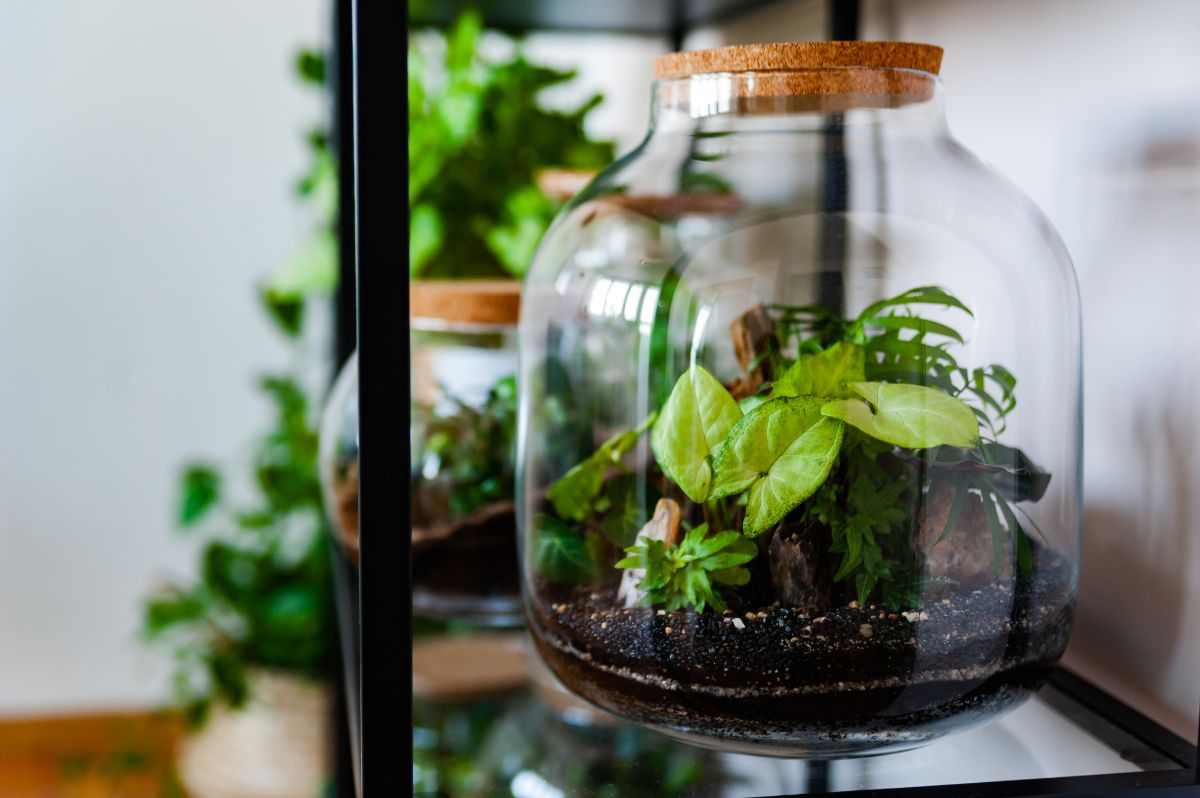
Small plants that love lots of humidity are perfect for closed terrarium setups. Some of the best choices include Venus flytraps, creeping figs, and nerve plants. For even more variety, you can also grow cacti, succulents, and other plants that prefer arid climates in open terrariums.
Depending on what plants you’re growing in your terrarium, you may need to adjust your lighting levels, but most terrariums do best with bright, indirect light. Full sun may be too intense for some terrariums, while certain plants (like Venus flytraps) do need some bright light to grow properly.
As with other houseplants, the most common mistakes with terrariums often involve too much or too little sunlight or water. Another common problem is potting up plants with different growing needs in a terrarium together. For this reason, it’s always important to do a bit of research on your plants before purchasing them to ensure you’re picking plants that will grow well together.
Most terrariums are closed systems without drainage holes, and they may become waterlogged and promote root rot without proper planning. To avoid this, terrariums should include a layer of gravel, pebbles, or other drainage material at the bottom to keep plant roots from sitting in water for too long.
How much you need to water your terrarium will depend on the plants you’re keeping and the type of terrarium you’re growing. Closed terrariums and open terrariums planted with cacti or succulents won’t need to be watered often, while open terrariums with tropical plants will need more attention. In general, most terrariums do well when watered lightly every 3 months or less.
Changing out the substrate in your terrarium from time to time can keep your plants healthier and help prevent any smelly soil or other issues. A good rule of thumb for proper terrarium maintenance is to refresh your substrate once a year.
Summary
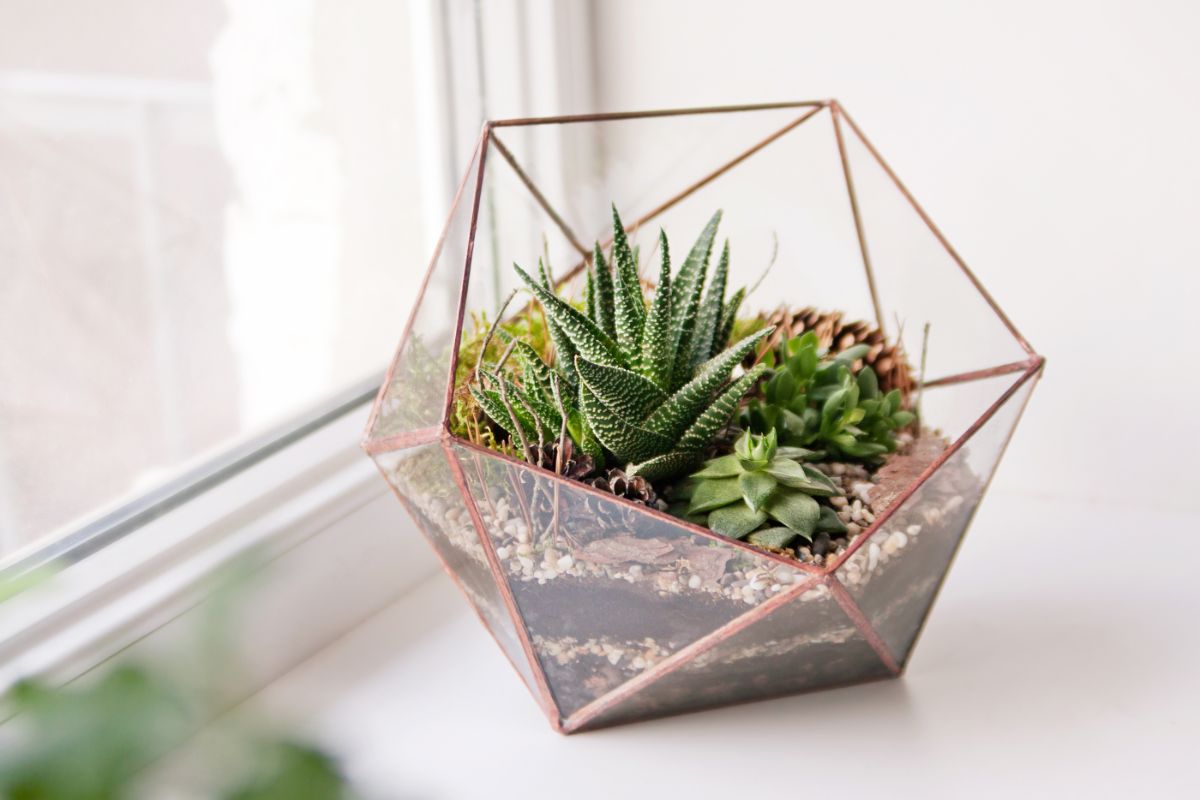
Terrariums are easy to keep, and they can simplify plant care for humidity-loving species. But there are plenty more reasons to try your hand at creating your own terrarium setup.
DIY terrariums encourage houseplant keepers to explore their creativity and design microhabitats that can play with plant texture, color, and form. Terrariums make striking tabletop features, while other terrarium kits can be suspended from hooks for a more vertical display. Whatever terrarium you decide to use, choosing the right plants is critical to keeping a successful terrarium.
Many of the plants that do well in terrariums are humidity-loving species that can be difficult to keep as houseplants outside of terrariums. While we’ve covered some of those plants today, if you’re still looking for the perfect plant, you can find even more houseplants that will do well in terrariums in this list!

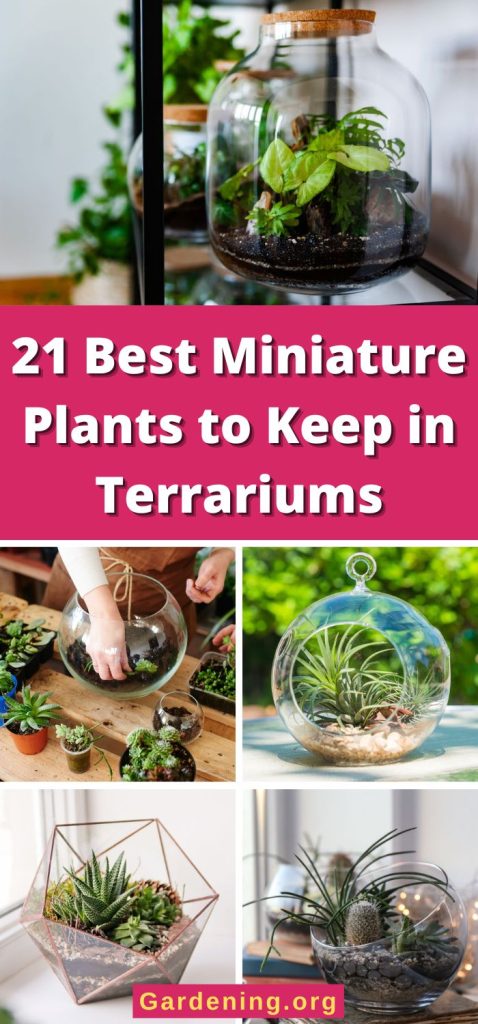
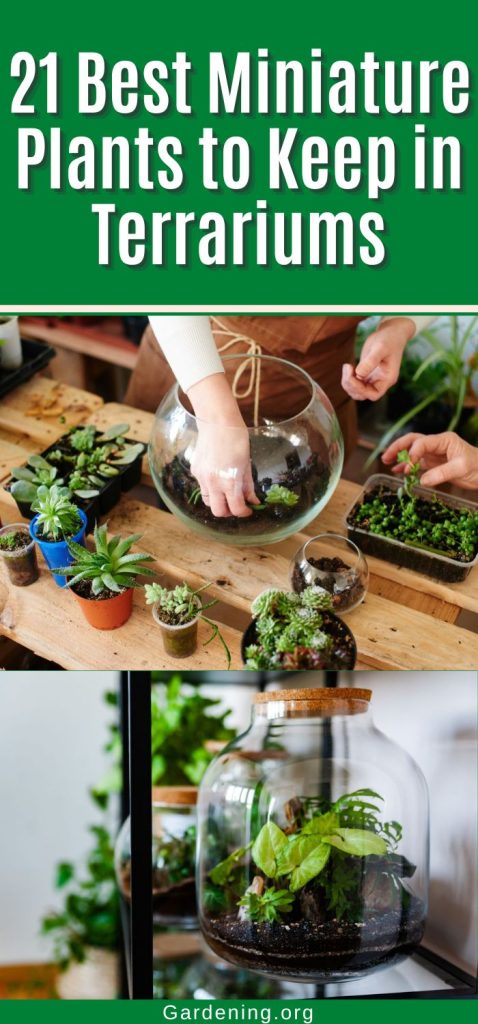
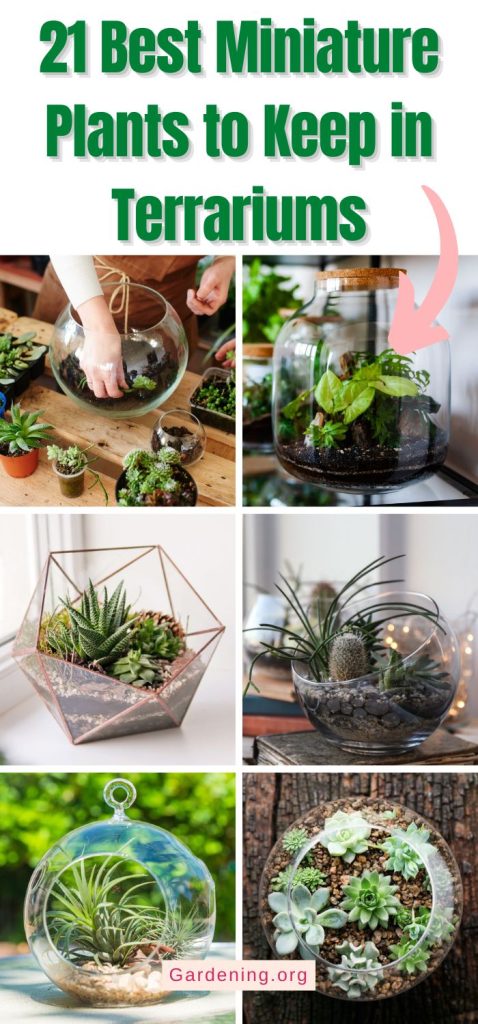
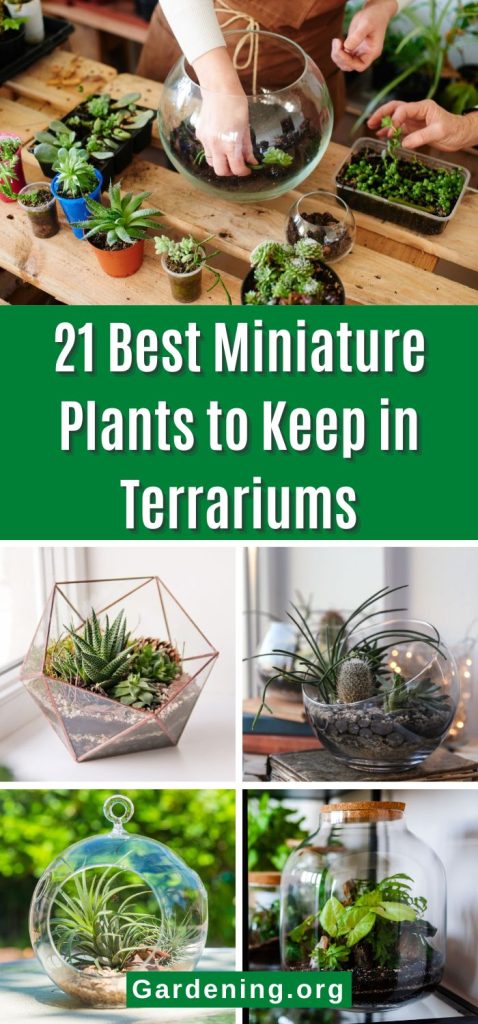
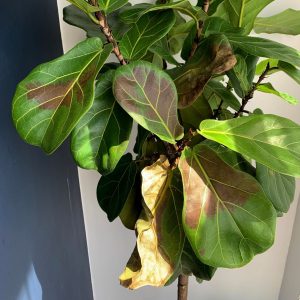
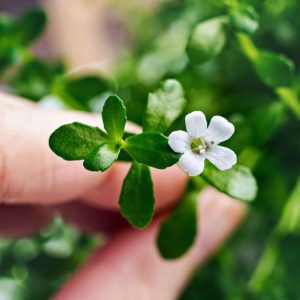
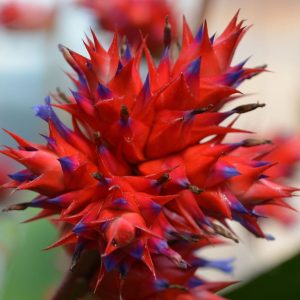

Leave a Reply